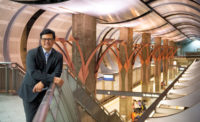...have survived hundreds of years of wind and flooding. “We are looking at how that overall shape could lend resilience in a windstorm,” and how the interlocking roots may be mimicked in a structural foundation, Baumeister says.
The Biomimicry Guild is working on creating interwoven foundations on an experimental project in Mumbai, India, as a subcontractor to HOK Planning Group of St. Louis.
Risky Venture
However, given U.S. property lines, laws and liability, such a project won’t likely come to fruition any time soon on the home front, Baumeister says. “We are such a litigious society, and no one is willing to take risk,” she says. “That has been a problem on several projects we’ve been working on. There is definitely an inclusion of existing biomimetic products in building (such as nontoxic paint), but a completely biomimetic building is not tried and true.”
One of the practical reasons is that no objective criteria exist for qualifying and measuring what constitutes a biomimetic structure.
“It’s emerging,” says Michael Plotnick, a spokesperson for HOK. “With emerging disciplines and sciences, there’s not a formula, model, checklist or book.”
Furthermore, applying biomimicry to building requires clients who are “eager and willing to explore” with companies like HOK, Plotnick says. Those are hard to find in the current economic climate.
In reality, few biomimetic projects are under way or even in design, says Jon Gardzelewski, a Laramie architect who teaches architectural design at the University of Wyoming. “From my experience, attempts to incorporate biomimicry are superficial marketing efforts at best,” he adds.
Gardzelewski likens the industry’s recent infatuation with biomimicry to the eagerness of firms racing to have the greatest number of LEED-accredited professionals on staff for marketing purposes rather than actually achieving more sustainable design and construction.
“Small academic types – really green people writing books, building little projects or their own houses – are leading the movement in biomimicry,” he says. “It’s really hard for big companies to start redoing things, and I don’t think we’ve bridged the gap between little grassroots efforts and big companies.”
Systems Approach
Still, biomimicry is being embraced by some as a challenge to push toward a new way of viewing construction. For decades, RNL of Denver has been known for its high-profile sustainable design projects, including the Research...




Post a comment to this article
Report Abusive Comment